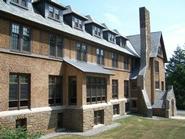
One day after the official celebration of Earth Day, Hamilton College will unveil a Silver LEED (Leadership in Energy Conservation) plaque certifying that Skenandoa House has met the conservation qualifications set by the U.S. Green Building Council (USGBC). Skenandoa House, an 84-year-old residence hall, is the oldest building in New York State to be so designated. Participants in the unveiling ceremony will include representatives from the USGBC, the architectural firm Ewing-Cole, the Oneida Nation, the Hamilton Environmental Action Group (HEAG) and Murnane Construction and Hamilton President Joan Hinde Stewart.
On Monday, April 23, at noon, a ceremony will take place at the north side entrance of Skenandoa House. The program will include brief remarks by President Stewart, Skenandoa renovation architect Charles Belson, Bear Clan Representative to the Oneida Nation Mens' Council Brian Patterson, Jim Hogel, president of Murnane Construction, Clint Hill, Oneida Nation Turtle Clan representative, and Steve Bellona, Hamilton associate vice president of facilities. The plaque will be unveiled by Tracie Hall, executive director of the New York State office of USGBC.
LEED certification of building projects is difficult to achieve, since the projects must meet or exceed myriad requirements. Five environmental categories are defined in LEED including: sustainable sites, water efficiency, energy and atmosphere, materials and resources and indoor environmental quality. Only 11 other buildings throughout New York State have been LEED-certified since the program began in 1999.
"The Skenandoa House is a building the students and community can be proud of," said Rick Fedrizzi, president, CEO and founding chair, U.S. Green Building Council. "This campus building will serve as a showcase for high-performance, energy-efficient, healthy buildings, and an inspiration for other colleges."
Built in 1922, the former Psi Upsilon chapter house was rededicated as Skenandoa House in 2004 in honor of the Oneida Indian chief and friend of Samuel Kirkland. In 1793 Kirkland founded the Hamilton-Oneida Academy that later became Hamilton College in 1812. The third college to be established in New York State, it is today among the oldest in the nation.
Historic and environmental stewardship were powerful allies in the process used by the architectural firm EwingCole to help Hamilton make Skenandoa House a model for environmentally responsive residence hall renewal on campus.
In addition to careful workmanship that restored the building's exterior to its original grandeur, the most notable feature is the use of "green" technology throughout. The renovations included a 16-well geothermal ground water heating and cooling system, individual thermostats in each room, energy efficient lighting, extensive building materials reuse and construction waste management.
Bellona, of facilities and planning at Hamilton, said, "Not only does Skenandoa House consume significantly less energy per square foot than our other relatively new residence halls, but our cost for renewable electrical energy, on a square foot basis, was less than other residence halls using non-renewable fossil fuels. This is an experiment for us, but so far we are pleased with the payback."
In its first year of operation, the geothermal system in Skenandoa House used 250% less energy per gross square foot than a standard gas-fired heating system in a comparable residence hall (47.6 mbtu/gsf vs. 123.2 mbtu/gsf).
The efficiency of the geothermal system is its overwhelming advantage. While conventional heating and cooling devices must convert outside temperatures to reach comfort levels, geothermal heating and cooling uses ground temperatures of around 55 degrees to help moderate the temperature differential. The process requires only electricity to run a heat pump and small circulation pumps, eliminating the use of natural gas.
All electrical power used in Skenandoa House is completely "green power" (wind, small hydro). While more expensive to purchase, green electrical power has reduced greenhouse gas production in carbon dioxide by 107.1 tons, nitrous oxide by 289.5 pounds and sulphur dioxide by 765 pounds. By purchasing 100 percent green power, Hamilton is also a member of EPA's Green Power Partnership.
Hamilton has recently committed to purchasing 10 percent of its energy from green energy sources. All campus building and renovation projects are now designed with a focus on LEED certification guidelines. Hamilton students also operate recycling and food salvage programs. The college community continuously researches additional conservation initiatives.
Skenandoa House is located on the north side of College Hill Road on the Hamilton campus. Parking is available at the back of the building. The schedule for the unveiling follows below.
Unveiling the Silver LEED Plaque
Skenandoa House
April 23, 2007 ~ Noon
Introductions: Steve Bellona, Associate Vice President of Facilities and Planning
Opening Remarks: President Joan Stewart
Comments:
Charles Belson, Architect, Ewing Cole
Brian Patterson, Bear Clan Representative to the Oneida Nation Men's Council
Jim Hogel, President of Murnane Construction
Unveiling: Tracie Hall, Executive Director
New York State Office of the U.S. Green Building Council
(with Charles Belson, Brian Patterson, Clint Hill and Joan Stewart)
Posted April 20, 2007
